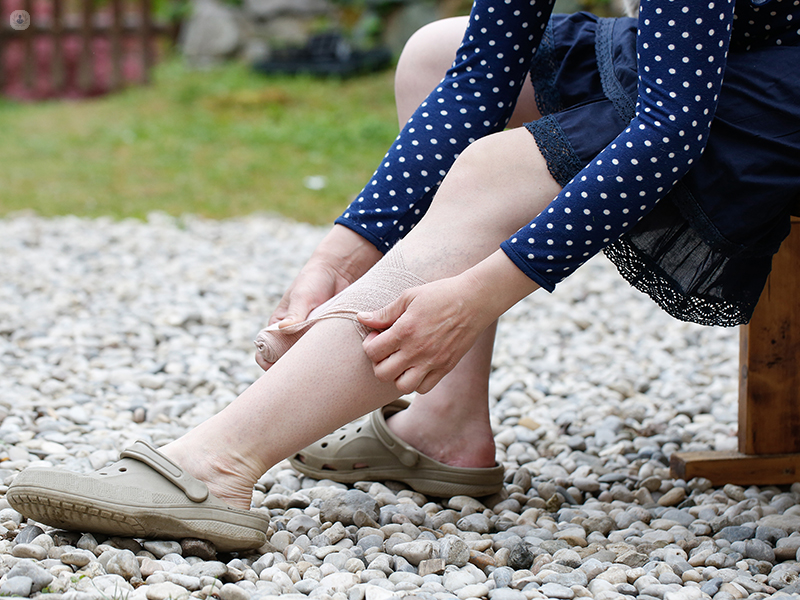The important thing to know about varicose veins
Written by:Varicose veins are dilated veins under the skin which are quite common. There can be several causes from prolonged standing (in people with the familial risk), raised venous pressure during pregnancy (if the patient already has “hidden varicose veins” before pregnancy) and faulty valves. The important thing to understand is that to treat varicose veins, we need to treat the underlying veins and not just the ones that can be seen bulging at the surface.
Professor Mark Whiteley talks about the different types of varicose veins and the importance of treating the ones that cannot be seen on the surface.

When most people think about varicose veins, they think about the lumpy, bulging veins seen on the surface, but we also have the underlying veins that are causing the surface veins to bulge. These underlying veins are not working properly and let blood flow out the wrong way, into the surface veins.
Underlying veins cannot be seen, but in order to get a good result from varicose vein treatment, it’s important to treat these underlying veins. Underlying veins are usually combinations of the three main types; saphenous veins, perforator veins and pelvic veins. Most doctors who treat varicose veins only treat the saphenous veins and the surface varicose veins because they are not experts in vein surgery. This failure to treat perforator and pelvic veins is one of the major reasons as to why varicose veins return after treatment.
What are the different types of underlying varicose veins?
There are three types of underlying veins:
- Long veins that run along the leg called saphenous veins. These carry blood up the leg to the heart, but if their valves fail, blood falls downwards with gravity, hitting the surface veins, causing the surface veins to dilate and stretch.
- Short veins that run from the superficial veins into the deep veins of the leg, ready to be pumped back to the heart. These are called perforator veins because they perforate the muscle. When valves in these veins fail, blood squirts from deep to superficial veins at the surface, causing surface veins to dilate.
- Pelvic veins that run from the leg to the pelvis to take blood back to the heart. When these veins have faulty valves, varicose veins can appear along the vulva and vagina in women and around the testicles in men (“varicocele”). They can also cause haemorrhoids or varicose veins in the legs.
How can underlying varicose veins be seen?
A special test called a duplex ultrasound is used to see underlying veins. If blood is flowing upwards in the veins or inwards through the perforator veins, the veins are working properly. However, if blood is flowing down the veins or outwards through the perforator veins, this is what’s called venous reflux and causes the varicose veins that we see on the surface. Any veins showing venous reflux need to be treated to stop the reflux.
Is an ultrasound an accurate way to look at underlying veins?
The accuracy of venous duplex ultrasounds depends on the machine used and the skill of the technologist performing the scan. Many doctors are ill-equipped to read the scan if they are not vascular technologists who are specifically trained. This is one of the reasons that the NICE guidelines on varicose veins state that patients should be treated by teams, not individual doctors.
Quick scans of less than 15-20 minutes performed by doctors who do not specialise in veins only look at the saphenous veins and don’t check the perforator or pelvic veins. Thus, even if a doctor has access to the best medical devices, treating varicose veins will be unsuccessful if they do not check all of the veins.
How are underlying varicose veins treated?
As we’ve seen, the treatment of varicose veins has to be split into:
- Firstly treating the underlying veins that cannot be seen from the surface (saphenous, perforator veins and pelvic veins)
- Then treating the varicose veins that can be seen on the surface
Saphenous veins are the ones that run along the leg are relatively easy to treat as they are quite long and large. However, they lie under a layer called “fascia” and cannot be seen from the surface. Perforator veins are more difficult to treat as they are short and small and run deep into the muscles. Pelvic varicose veins are only treated in highly specialist units.
In another article, Professor Mark Whiteley talks about treating the underlying saphenous veins and perforator veins (in some specialist clinics) with endovenous laser ablation (EVLA). This is an image-guided, minimally invasive treatment that uses laser energy to burn and close abnormal veins that lead to varicose veins.
Other techniques include the older radiofrequency ablation that has some drawbacks, or the newer microwave ablation that has some advantages. The major advantage of using heat (ablation) to close off underlying varicose veins is that provided the right amount of energy is used for the size of the vein being treated, the veins shouldn’t open again.
In order to remove the varicose veins that can be seen on the surface, doctors often combine EVLA with a phlebectomy or sclerotherapy.
For more information about the causes of varicose veins, check out Professor Whiteley’s book “Understanding venous reflux: The Cause of Varicose Veins and Venous Leg Ulcers.” You can also make an appointment with Professor Mark Whiteley via his Top Doctors profile today.


